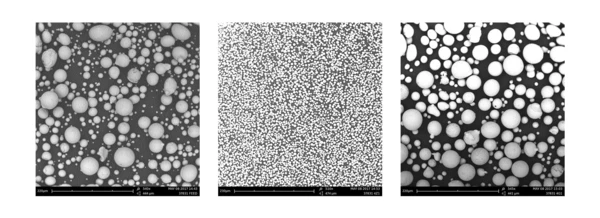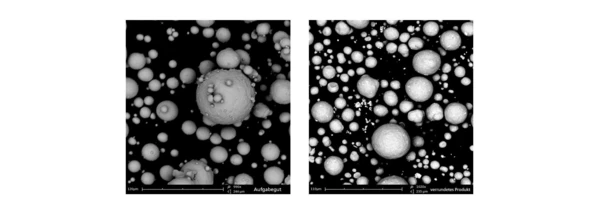State of the art
In particular the 3D-printing market is currently experiencing a period of very rapid growth. An ever-increasing number of applications in the area of the automobile industry, aircraft construction, tool manufacture and prototype construction are based on the AM process.
3D-printing has made it possible to manufacture complex shapes with defined characteristics. Previously it was impossible to manufacture such parts or they could only be manufactured by joining together several parts.
The advantages are obvious:
- Components are lighter (weight saving of up to 80%)
- Components are smaller
- Quality can be controlled and therefore fewer rejects are produced
- Components have improved characteristics as cavities are single and complex shapes can be manufactured
- Development times are considerably shorter as prototypes can be manufactured immediately after the design phase
During the currently used printing process a 20-100 μm thick coating of metal powder is applied. Then, a laser melts the metal powder at the points at which the part is to be produced, so that the metal particles fuse. Afterwards another coating of powder is applied and the process repeated. This procedure is then repeated until the part is finished. Production times range from 2 - 24 hours, which means that the use of this method in serial production is still limited.
Metal powders used for high-quality applications in the area of „Additive Manufacturing“ (AM as well as 3D-printing) are produced in different ways by gas, water or plasma atomization. Unfortunately, an exact and very narrow particle size distribution, which is required for 3D-printing, cannot be obtained using this process method. Therefore, after the atomization process the raw material needs to be classified to ensure a steep particle size distribution to get a product that is tailored to the particular requirements of the end application.
Application Example – Dedusting of Stainless Steel Powder
In order to ensure that a good quality product is produced, it is important that the powder used has a narrow particle size range, typically from 20 to 60 μm.
In this way separation technology plays a decisive roll and this is where the NETZSCH classifier of the series CFS/HD-S comes into play.
The sharp separation in the dedusting process obtained with the High-Efficiency Fine Classifier CFS/HD-S was impressively demonstrated during the manufacture of metal powders for technically demanding applications. The feed product - stainless steel powder had a fines fraction of 5 % < 11 µm. The aim was to refine the product by reducing the fines fraction to 5 % < 15 µm.
Tests were carried out on a laboratory classifier CFS 8/HD-S (approx. 80 Nm³/h air). Due to the high bulk density of the stainless steel powder of 4.5 kg/l a lower classifier speed (approx. 17 % of the maximum speed) was required. The fines fraction was separated out rapidly and reliably and in the final product the 5 % fraction of dedusted product had a particle size of above 21 µm, therefore exceeding the specification of 15 µm by approx. 25 % (Fig. 1 and 2). The next important criterium for the evaluation of the dedusting performance is the yield, as the dust which is separated out is often not used in the actual application. In this test the yield was an impressive 98.7 % which means that product loss was a mere 1.3 %.

In addition, the rapid changing from one product to another was important as each stainless steel powder has its own particular composition. For this reason, a further important criterion was the easy access to and cleaning of the NETZSCH classifier plant. This is ensured by the housing door which can be opened on hinges and the guide vane basket which can be removed.

A production plant with a significantly larger classifier was then designed based on these results obtained in the NETZSCH test lab. The novelty of the complete concept of the classifier plant is that the classifier air is operated in a loop and the fine dust is almost completely discharged via a cyclone! A filter is not necessary. This is made possible thanks to the high density of the product. It is therefore possible to collect the different dusts individually after a product change and with very little cleaning effort. Using this plant design from NETZSCH it is possible to reliably dedust amounts of metal powders of over 100 kg for the manufacture of additives. At the same time a high availability is ensured. In this way the powder manufacturer can react quickly and flexibly to customer demands.
Application Example – Dedusting of Titanium Powder (Ti6Al4V) for 3D-printing
One of the best-known alloys for 3D metal printing is the titanium alloy Ti6Al4V, which is characterized by excellent mechanical properties. The material has the highest strength values at low weight, which is why it is used for demanding aerospace applications, for example, and is also corrosion-resistant. Titanium alloys are also used in medical technology, for example as implants, due to their very good biocompatibility.
To ensure that the properties of the 3D-printed component are consistently achieved, the powder must have a high sphericity, smooth surface without satellites and a uniform particle size distribution. Such spherical titanium or titanium alloy powders can be produced using plasma atomization, for example. In this process, a wire made from the alloy to be atomized is fed to plasma torches through which it is melted and atomized in one step. During this process, small satellites can also adhere to the powder (Fig. 3 Feed material), which can negatively influence the 3D printing process and therefore ideally have to be separated again.
Such satellites can be removed from the surface of the powder particles by stressing in a modified m-Jet high density bed jet mill. This is done in a closed process under a protective gas atmosphere, since a low residual oxygen content is also required.
The SEM images (Fig. 3) of the product before and after processing clearly show that the interfering satellites could be removed.

High-efficiency Fine Classifier CFS/HD-S
The NETZSCH High-efficiency Fine Classifier CFS/HD-S (High Dispersion) works very efficiently due to its closely defined sharpness of cut and its very specific product flow. Mixing of the classified coarse material and feed material inside the classifier cannot occur.
A significant improvement in throughput has been made possible by a specially designed housing: the screw-shaped design of the housing optimizes the product flow within the unit. This allows large quantities of coarse material to be discharged unhindered through the product outlet. Accessibility and easy cleaning of the machine are guaranteed by the hinged housing door and the removable guide vane basket.
- Guide vane ring with adjustable vanes for efficient dispersion of the feed product prior to classification
- Classifier wheel with exchangeable, simultaneously rotating immersion tube to achieve highest finenesses, unlimited adjustment
- Gap between classifier wheel and fines outlet rinsed by gas for highest possible prevention of oversize material in the fine fraction
- Extremely sharp separation for improved fines extraction
- Highest finenesses and maximum throughput achievable with just one classifier wheel
- Very good access for fast, easy cleaning and maintenance
- Reproducible results
Conclusion
Depending on the product, new technologies such as additive manufacturing always bring new requirements for the machine technology to be used. Machine manufacturers in the field of mechanical process engineering take these requirements into account both in the solution of product-related new tasks and in the technical design of machines and systems. In the NETZSCH application laboratory, which is equipped with the latest technology and is part of the comprehensive range of services, test runs are possible, for example, with the technologies described in various sizes from laboratory to production scale. Product samples are processed under production conditions and their behavior analyzed in order to achieve the best result with maximum efficiency.